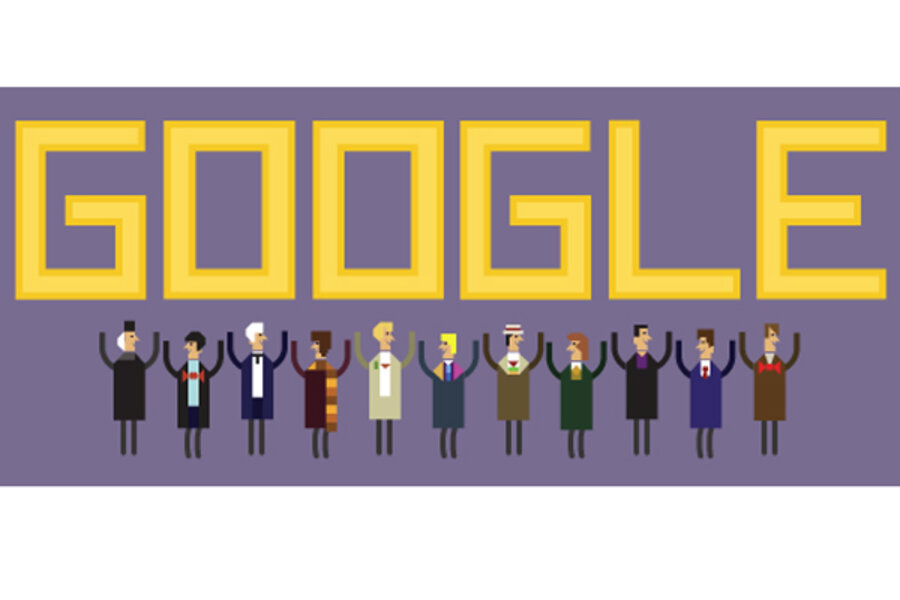Doctor Who: On 50th anniversary, Google shares a 'Whodle'
Loading...
Doctor Who, the long-running British science-fiction series, is entering its 50th year on TV, and in celebration, Google has launched what's being called a "Whodle" – a multi-level video game starring all 11 of the program's Time Lords. To launch the game, click on the play button in the center of the doodle, and select your doctor. The puzzle-platformer, which bears a passing resemblance to several classic games, will boot to life immediately.
Whovians should recognize a range of staples from the television show, from the Daleks and the Cybermen to TARDIS itself.
"The thing is that [Doctor Who is] a Time Lord, a time traveller, so I really wanted to get the feeling across that you could travel to different eras," Google doodle designer Matthew Cruickshank told the Guardian this week. "I definitely didn't want you to just play one level and that is it, I love the idea of the Doctor being able zoom around the universe." (And yes, doodle designer is Cruickshank's real, full-time job.)
As the Guardian points out, the "Whodle" comes after extensive lobbying from the Doctor Who fanbase, including an online petition that racked up 4,000 signatures. "Doctor Who is a show that changed my life," one petitioner noted a month ago. "It not only has been a way to be entertained, but it also has been a way to connect with people. Some of my greatest friends were made because of a shared passion for Doctor Who."
The very first episode of Doctor Who premiered in November of 1963 on the BBC. The protagonist was played by British actor William Hartnell, who was to remain in the role for three years, until 1966. Hartnell's Doctor was old and a little grumpy; he sometimes supported his weight with an ebony walking stick. From the BBC synopsis of the pilot:
Schoolteachers Barbara Wright and Ian Chesterton become intrigued by one of their pupils, Susan Foreman, and visit her home address – a junkyard at 76 Totter's Lane – where they meet her grandfather, the Doctor. The Doctor and Susan are aliens who travel through time and space in their ship, TARDIS, which looks like an ordinary police box but actually houses a huge gleaming control room.
Later, the Doctor and Susan, aided by Chesterton and Foreman, do battle with the malicious Daleks; they travel to France at the height of the Revolution, and to Mexico, where they visit with the Aztecs. Over the years, the hectic pace of the time-traveling stayed the same, but the hero changed quite a bit. In 1966, the First Doctor collapsed and returned, through a mysterious process, as the Second Doctor, played by Patrick Troughton.
Troughton was replaced by Jon Pertwee; Pertwee by Tom Baker. In 1989, production on the program was officially suspended (although a less-than-totally successful movie did follow in 1996). For years, the Doctor Who franchise remained dormant, until BBC One revived the series in 2005, where it has remained ever since, to great critical and popular success.
In its newest iteration, the mantle of Doctor has been donned by three separate doctors, perhaps the most beloved of which was the rubber-faced Christopher Eccleston. The 31-year-old actor Matt Smith currently plays the series' lead, although the BBC says he will end his tenure as Time Lord. His replacement? Peter Capaldi, a Scottish veteran of big-budget flicks such as "World War Z."
"It's been an honor to play this part, to follow the legacy of brilliant actors, and helm the TARDIS for a spell... But when ya gotta go, ya gotta go," Mr. Smith said in June.
In an appreciation on the Hero Complex blog in March, Robert Lloyd wrote that "loss is the heart of the show" – the successive loss of one beloved character and the introduction of the next.
"[I]t is a show about people who are meant to be together," Lloyd concluded. "And behind all the swashbuckling, the suspense, the horror and the fun, beats a tale of love and friendship and bonds that the farthest reaches of space and time cannot break."







